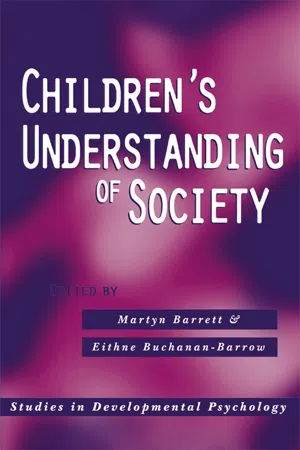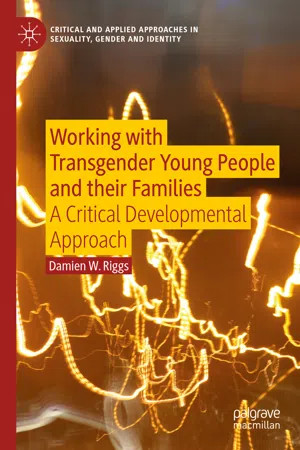Psychology
Gender Development
Gender development refers to the process through which individuals acquire an understanding of their own gender identity and the societal expectations associated with being male or female. This process is influenced by biological, social, and cultural factors, and typically begins in early childhood. It encompasses the development of gender roles, behaviors, and attitudes, and continues to evolve throughout the lifespan.
Written by Perlego with AI-assistance
Related key terms
12 Key excerpts on "Gender Development"
- eBook - ePub
- Michelle K Ryan, Nyla R Branscombe, Michelle K Ryan, Nyla R Branscombe(Authors)
- 2013(Publication Date)
- SAGE Publications Ltd(Publisher)
Gender plays an important role in people’s lives across the lifespan. In the early years of development, gender influences how infants are named, dressed, and treated. Later in development it influences the academic courses students select, the skills they master, and those they leave undeveloped. It further influences occupational choices, the centrality of family in daily life, and the level of financial attainment. In this chapter, the sequence of Gender Development is charted across the lifespan and the influence of gender on human development is considered. First, the developmental patterns of the most researched gendered social cognitive conceptions, namely, gender identity and gender stereotypes, are examined by addressing the central questions of ‘How do children come to view themselves as gendered individuals?’ and ‘How do children develop beliefs about gender differences?’ This is followed by an analysis of gender differences and similarities, addressing the question ‘To what extent are behaviors, activities, attributes, and preferences patterns linked to gender?’ After discussing these three central questions, the major biological and social influences on Gender Development are reviewed. A brief summary of the key theoretical positions advanced to explain Gender Development follows and directions for future research are considered.THE DEVELOPMENTAL SEQUENCE OF GENDERED SOCIAL COGNITIVE CONCEPTIONSBefore discussing the key gendered social cognitive concepts of gender identity and gender stereotypes, a comment about the terms ‘gender’ and ‘sex’ is warranted. Although these terms are sometimes differentiated, with gender being reserved for activities and behaviors that are influenced by social factors and sex for those activities and behaviors that are influenced by biological factors (Frieze & Chrisler, 2011), here the terms are used interchangeably without any attribution about whether the underlying influence is biological or social. The reason for this is that for most gender differences both biological and social factors are involved and it is not possible to attribute the contribution of each of these sources.Gender IdentityGender identity typically refers to a person’s gendered self-characterization. It involves more than self-categorization as male or female. Self-representational structures and selfregulatory processes contribute to the gender identity people create for themselves as do the ways they are treated on the basis of their gendered social identity (Bandura, 2008; Bussey, 2011). Although gender identity develops over the lifespan, most developmental research has focused on the early years and children’s attainment of gender identity knowledge.In Kohlberg’s (1966) classic account of Gender Development, the role of gender identity was central. He proposed that once children understand that their gender identity remains constant across time and situations (gender constancy) they self-socialize themselves to behave in accord with stereotypical gender roles. Gender constancy comprises (a) the ability to label one’s own and others’ gender (gender identity), an understanding that gender remains constant over time (gender stability), and (b) the understanding that gender remains constant across situations regardless of the gender linkage of clothes worn and activities performed (gender consistency - eBook - ePub
Developmental Psychology
A Course Companion
- Carol Brown(Author)
- 2008(Publication Date)
- SAGE Publications Ltd(Publisher)
Development of the social self. Psychology Press: Taylor & Francis group. Using a social identity theory perspective this text examines the acquisition and development of children’s self-identity.ERIKSON, E. H . (1968). Identity: youth and crisis. New York: Norton. A look at the complexity and trials of social identity stages in the lifespan.HARTER, S . (2001). Construction of self: a developmental perspective. Guildford publications. A research-based text that looks at self-development and self-representations.2.9
Gender Development
Core areas
- Biosocial theory
- Cognitive-developmental theory
- Electra complex
- Gender consistency
- Gender identity
- Gender schema theory
- Gender stability
- Oedipus conflict
- Psychoanalytic theory
- Sociobiological theory
- Social learning theory
Learning outcomes
By the end of this section you should be able to:- define and understand the key concepts above;
- describe each of the explanations offered for Gender Development;
- show an understanding of whether they are psychological or biological theories, or both;
- evaluate the theories in terms of the research evidence available to support them;
- understand the limitations of each approach.
Running themes
- Cognitive-developmental viewpoint
- Nature
- Nurture
- Psychoanalytic viewpoint
- Stage theory of development
- Transformational change
Introduction
Gender itself refers to the psychological characteristics associated with being male or female. Gender identity goes beyond the biological aspects focusing on the awareness of being male or female and will include aspects of gender role (expectations about gender-appropriate behaviours) based partially on stereotypes. It is the first step in the development of the child’s self-concept as it helps it label itself according to gender and therefore start to label others in a similar way. - eBook - ePub
- Nancy Fenton, Jessica Flitter, Jessica Flitter(Authors)
- 2015(Publication Date)
- Research & Education Association(Publisher)
androgyny .Gender roles , or the expected appearance, personality traits, and behaviors connected to being male or female, mainly relate to environmental factors, such as family and cultural interactions. Characteristic male gender roles include men being independent, strong, and self-assured. Traditional female gender roles include the expectation that women will be nurturing, dependent, and emotional. Gender roles help individuals develop a sense of identity and understand others. It is very difficult to tell whether gender roles reflect an inherited tendency or are the result of socialization. There are some observable differences in male and female development, but separating the nature from the nurture influences in the study of gender differences is difficult due to many intervening variables. One clear biological fact is that females tend to mature earlier than males, typically at age twelve, as compared to age fourteen for males. However, other differences between the genders are less likely to be related to biological causes. For example, girls who reach puberty early have more anxiety than do boys who mature early. Other characteristics—aggression, for example—are more complicated because, although males demonstrate higher levels of aggression, it is difficult to tell if this is the result of differences in biology, such as the fact that males have more testosterone, or differences in how aggression is reinforced or shaped by family and culture. The problem with attributing these gender differences to genetics is that it is very difficult to separate heritable traits from cultural experience and training, especially in the realm of complex social behaviors, including aggression or performance on standardized tests. Socialization is the process of developing the abilities, attitudes, and behaviors required for successful functioning within a particular culture or group. One aspect of socialization is the acquisition of gender roles, which is called gender typing - eBook - ePub
- Martyn Barrett, Eithne Buchanan-Barrow(Authors)
- 2004(Publication Date)
- Psychology Press(Publisher)
In sum, there is no doubt that the media present stereotyped, if occasionally heterogenous, representations of gender roles and there is no doubt that children are avid consumers of the media, especially television. However, this correlation does not confirm a unidirectional causal relationship in respect of children's own gender role development or their understanding of gender roles in society. Instead, consistent with the broad thrust of cognitive developmental theories (and some aspects of social cognitive theory), children turn out to be discerning viewers who attend selectively to the material available and interpret it in accord with their developing naїve social psychologies of gender and their personal (though gender-linked) preferences. They also, once again, filter the information through affective processes, and are quite ready to reject ideas and images if they are incompatible with their theories and values.CONCLUSIONS
Gender is given, grown, imposed, expected, regulated, learned, reflected upon, enacted, experienced, and shared. In this complex, multifaceted, and multidetermined minefield, children are actively engaged as thinkers and as emotional beings striving to determine who they are and how they relate to the social structure. Early attempts to explain gender role development tended to ignore or neglect the child's understanding. Cognitive developmental theories corrected this and inspired a large body of fruitful research, though these theories in turn have tended to neglect how children feel about gender. As in much cognitive developmental work, they tended to treat the child as a cognitive isolate or mini-scientist engaged in interesting epistemological quests with little reference to anyone else. Recent developments within cognitive developmental theory and at the points of intersection with social psychology have brought social processes and motivational and affective considerations more to the fore.Two issues emerge to guide future research. First, although children's understanding of gender roles in society is, of course, subject to developmental processes, it is becoming apparent that it is misleading to conceive of it as an incremental body of knowledge that is static at a given point in development. Instead, it is fluid, context sensitive, and socially shared and may be expressed or accessed in different ways in different circumstances.Thus, the task ahead is not so much to refine our maps of what is known at different ages or stages but rather to investigate how children draw upon their developing knowledge to meet specific demands as social actors.Second, understanding gender in society is closely linked to emotional processes. Gender is motivating to children as highly personally salient information, as a fundamental organising feature of any community, and as a framework of values in relation to which feedback is received almost continuously from other people and institutions. Importantly, the cognitive engagement can be constrained by the emotional engagement. For example, increasingly sophisticated and flexible knowledge can be put aside in suf- ficiently motivating contexts of intergroup rivalry, where the young person may revert to simplistic, even prejudiced, stereotypes, or in contexts where gender identity might be threatened in other ways (for example, by being asked to wear frilly pink dresses, which will be declined not only by 5-year-old boys with strong gender stereotypes but by a majority of males in most other age groups). We still have much to understand about how children come to understand gender roles in society, but finding out more holds enticing prospects of improving our accounts of how developing human beings mediate the complex relations between biology and social structure. - (Author)
- 2015(Publication Date)
- Wiley(Publisher)
The gendering process involves many different types of influences, beginning at the moment of conception and continuing across the lifespan. These influences include genetic information on the sex chromosomes; fetal and neonatal concentrations of testosterone and perhaps other hormones; socialization by parents, peers, teachers and others; and self-socialization based on cognitive developmental processes associated with gender. Although discussions of gendered behavior often ask whether nature or nurture has the more important influence, this view of a primary force—either nature or nurture—driving gendered development is mistaken. As the developmental systems perspective suggests, not only are many different types of influences involved, but these influences interact with one another over time to produce stability and change in gendered characteristics. Gendered behavior can differ for a single individual in different contexts, and the factors that contribute to gendered development and their interactions can differ from one individual to another and from one time to another. The current state of knowledge is such that the elements of the developmental systems governing Gender Development are still being identified, but enough is known to be confident that these elements include some that would typically be classified as nature, such as genes, some that would typically be classified as nurture, such as socialization by parents, and some that do not fit clearly into either of these two categories, such as the prenatal and neonatal hormone environment. Thus, not only is it unhelpful to try to choose between nature and nurture in understanding Gender Development, it is not even possible to clearly separate nature and nurture in this context.Given the complexity of gendered development, it would not be possible for a single chapter in this Handbook to cover the topic in sufficient detail. In light of this, the Handbook includes two chapters that focus on gendered development. One of these includes in-depth information about social and cognitive factors involved in gendered development (see Leaper, Chapter 19, this Handbook, Volume 2), whereas the current chapter includes in-depth information about hormonal factors involved in gendered development. The current chapter also includes some discussion of social and cognitive factors, and how they work together with other types of factors, such as the early hormone environment, but interested readers are referred to the chapter by Leaper for a more detailed treatment of the social and cognitive processes involved in gendered development.Which Behaviors Are Gendered and How Large Are the Differences Between the Sexes?
In this chapter, the term gendered is used to describe psychological characteristics or behaviors that differ on the average for groups of men and women or groups of girls and boys. Historically, sex and gender have been distinguished, with sex referring to a person's biological sex, as defined by characteristics such as whether the gonads are ovaries or testes or whether the 23rd pair of chromosomes is two Xs or an X and a Y, and gender referring to other differences. In keeping with this tradition, I use the terms gender and gendered to describe psychological and behavioral differences between males and females. I do not, however, use the term gender- eBook - ePub
Growing Points in Developmental Science
An Introduction
- Willard W. Hartup, Rainer K. Silbereisen(Authors)
- 2005(Publication Date)
- Psychology Press(Publisher)
Sometimes the use of the word “stereotypes” is taken to mean that attributes assimilated to social categories are arbitrary, so that our concepts about the two sexes may be quite artificial or distorted. How accurate are our gender stereotypes? In their review, Deaux and LaFrance (1998) note that it is hardly possible to check the reality base of some of our stereotypes, since they refer to characteristics that are very difficult to measure objectively. People’s beliefs about certain attributes of the two sexes that can be objectively assessed, however, turn out to be quite accurate (e.g., that women are more involved than men in the care of young children). This work has been done with adults, and we can only assume that the accuracy of children’s gender stereotypes would improve with age, as they accumulate information about a larger and larger sample of exemplars.At the end of the twentieth century, then, a predominant perspective on Gender Development is a dual one focusing on individual differences. Its central themes are that children will differ in the degree to which they become sex-typed as a result of (a) the strength of the socialisation pressures they have experienced, and (b) the nature and coherence of their gender schemas—their knowledge about the characteristics stereotypically associated with each sex, and about what the social expectations are for persons of their own sex. Or course, socialisation and cognitive factors in Gender Development are not truly distinct. For example, socialisation pressures are one source of information enabling children to develop their knowledge concerning the gendered norms that they are expected to adopt. The direct socialisation experiences children have, in other words, constitute a major source of information upon which cognitive structures are built. Indeed, the whole cultural milieu in which a child grows up presents to children an array of cultural beliefs and practices concerning gender, and when children draw on these to construct their gender schemas, it can reasonably be said that they are being socialised by the surrounding culture into becoming co-practitioners of these cultural forms.An emphasis on cognitive and socialisation factors by no means precludes a recognition of possible biological influences that may generate different predispositions in boys and girls. Nowadays there is widespread recognition of the importance of biological factors. However, since biological sex and socially ascribed gender are so completely redundant, it has proved difficult to tease them apart. Something is known concerning sex differences in brain structures and functions. For example, in males, more functions are lateralised, so that they are associated with activation primarily in one hemisphere of the brain, whereas in females, the two hemispheres are more likely to be both activated for a specific function. However the possible behavioural impacts of these structural differences are far from being understood. A good deal is known concerning the physiological events during gestation that differentiate the genital structures of male and female foetuses. And we know, too, something about the way in which prenatal hormones organise the developing foetal brain so as to create different propensities and sensitivities in the two sexes—tendencies that will manifest themselves behaviourally at various times during postnatal development, perhaps requiring either a biological or environmental trigger for their activation. - eBook - ePub
Women's Lives
A Psychological Exploration
- Claire A. Etaugh, Judith S. Bridges(Authors)
- 2023(Publication Date)
- Routledge(Publisher)
cross-gender behavior in boys but not girls is considered a sign of actual or potential same-sex sexual orientation. Several investigations have provided support for this perspective. For example, Emily Kane (2006) found that parents of preschoolers accepted gender nonconformity in their daughters but not in their sons. Two-thirds expressed negative reactions to their sons’ dressing up in feminine attire, wearing nail polish, or playing with Barbie dolls, and several expressed fears that such activity meant that the son either was gay or would be perceived as gay.Summary
GENDER SELF-CONCEPT
- Gender self-concept includes gender identity and gender attitudes.
PRENATAL DEVELOPMENT
- Prenatal sex differentiation is a multistage process. The joining of the sex chromosomes at conception is followed by the differentiation of the gonads, the development of the internal and external reproductive organs, and the organization of the hypothalamus.
- After the gonads develop, the presence or absence of androgens influences the development of the reproductive organs and possibly the brain.
- Estrogens appear to play a role in female development.
MULTIPLE GENDERS
- Many non-Western cultures recognize multiple genders. Western cultures typically recognize only two.
INTERSEXUALITY
- Some individuals experience variations in their prenatal development known as inter-sexuality.
- Turner syndrome is a chromosomal disorder in which the individual has a single X chromosome. These individuals are raised as girls and have female gender expectations, but no sex glands or prenatal estrogen.
- (Author)
- 2015(Publication Date)
- Wiley(Publisher)
The chapter is divided into six sections. First, I present an overview of major social-cognitive theories pertinent to our contemporary understanding of Gender Development. Second, I summarize developmental patterns and variations in children's gender cognitions. Third, I examine the development of gender-typed play. Fourth, I review research comparing girls' and boys' competence and achievement in academic, athletic, socioemotional, and other domains. Fifth, I consider possible explanations for these average differences. Finally, to close the chapter, I offer two recommendations for future theory and research.Overview of Major Theories and Conceptual Models
When Maccoby and Jacklin's (1974) review was published 40 years ago, only a handful of theoretical approaches guided developmental research on Gender Development. In subsequent decades, theories and models have proliferated. I briefly review some of the major approaches relevant to the study of Gender Development. These include cognitive-developmental and information-processing theories, intergroup theories, motivation theories, and theoretical models of person–environment interactions. In subsequent sections, I elaborate on how these theories are relevant to our understanding of various facets of Gender Development.To limit the scope of the chapter, the focus is on social and cognitive explanations, although it is important to acknowledge that genes, hormones, and the nervous system influence Gender Development. A separate chapter in the current Handbook addresses these processes (see Hines, Chapter 20, this Handbook, Volume 3).Cognitive-Developmental and Information-Processing Theories
Several cognitive theories relevant to children's Gender Development similarly address the importance of observation and making inferences about the world. According to these theories, children actively use their understandings of gender to guide behavior. In this manner, the theories characterize Gender Development as a process of self-socialization. They vary in some of their assumptions or the relative emphases they place on particular processes.- No longer available |Learn more
Gender
Psychological Perspectives, Seventh Edition
- Linda Brannon(Author)
- 2016(Publication Date)
- Routledge(Publisher)
The word role was French for roll, and this usage is particularly meaningful, if we consider that the role, or the part a person plays, differs from the person. Therefore, gender roles are like scripts that men and women follow to fulfill their appropriate masculine or feminine parts. Social scientists use the term role to mean expected, socially encouraged patterns of behavior exhibited by individuals in specific situations. Does the color pink make that much difference in learning about gender? These images and their power to shape attitudes and behavior are important for social learning theory, one of the theories of Gender Development. But gender identity, which is how individuals come to identify themselves as male or female, is more complex than stereotypical associations. How that process occurs is unquestionably important but also controversial, and several very different theories attempt to explain how individuals come to accept themselves as female or male. Social learning theory emphasizes the importance of models and experiences, but the psychodynamic approach does not look to role models to explain the development of gender identity. Gender schema theory holds that the process involves much more than modeling. Each of these theories has advocates and supporting evidence, which requires an examination of the theories and the evidence. The Psychodynamic Approach to Gender Development Sigmund Freud, a Viennese neurologist, devised a theory that emphasizes the differences between personality development and functioning of men and women. Developed during the last part of the 19th century, Freud’s theory emphasized the dynamic forces that interact in forming personality, especially those originating in the unconscious, a region of the mind that functions beyond conscious personal awareness. His theory was controversial and remains so, partly because his theory casts women as inferior to men - eBook - ePub
The Handbook of Life-Span Development, Volume 2
Social and Emotional Development
- (Author)
- 2010(Publication Date)
- Wiley(Publisher)
Cognitive developmental theorists explain the motivation for observational learning in children, and social cognitive theories posit that cognitive processes play an important role in the acquisition of sex-typed behavior (Bussey & Bandura, 1984). Cognitive developmental theorists propose that children’s gradual acquisition of the gender concept, from initial identity as male or female through to an understanding that this identity will not change with time or with changes in appearance or activities, underpins the adoption of gender-appropriate behaviors (Kohlberg, 1966; Ruble & Martin, 1998). Cognitive theorists also posit that children are active agents in their own Gender Development, and that gender schemas, or systems of knowledge related to gender (similar to stereotypes), are involved in the acquisition of sex-typical behavior (Martin, Ruble, & Szkrybalo, 2002).Children are more likely to model the behavior of people of the same sex than the other sex, and this is particularly true for boys. After seeing videotapes of men and women consistently choosing one or the other of a pair of neutral items (e.g., an apple vs. a banana), children subsequently express more interest in the items that they have seen people of their own than the other sex choose, and the impact of the models is greater for boys than for girls (Perry & Bussey, 1979). Gender labels, which also tell children what items or activities are for their own versus the other sex, also influence children’s choices. If told, for instance, that brown xylophones are for boys and yellow xylophones are for girls (or vice versa), children tend to prefer the xylophone of the color they were told is for their sex (Masters et al., 1979). Television and other media are another source of information about gender-related behaviors, and the portrayal of males and females on television is highly sex stereotypical (Ruble, Martin, & Berenbaum, 2006). Television viewing also relates positively to sex stereotypic beliefs (Huston et al., 1992; Morgan & Shanahan, 1997). Although it is not possible to separate cause and effect in these studies of television and sex stereotypes (e.g., watching television may increase sex-stereotypic beliefs or people with stronger stereotypes to begin with may watch more television), the findings are consistent with predictions based on laboratory studies of the effects of modeling and labeling, lending some credence to the first interpretation. - eBook - ePub
The Psychology of Human Social Development
From Infancy to Adolescence
- Sandie Taylor, Lance Workman(Authors)
- 2018(Publication Date)
- Routledge(Publisher)
Plate 8.4 A girl’s and boy’s stereotype of what it is to be mum and dad. (Shutterstock 195221240.)Gender is one example of a social category that we become aware of early on in our development. Gender is a culturally defined social category used to distinguish between femininity and masculinity. This is not to be confused with biologically driven sex divisions of female and male. Individuals are born female or male (with the exception of hermaphrodites who are born with ambiguous genitalia) but become feminine or masculine through complex developmental processes occurring early on in the lifespan. In Chapter 6 we considered how a gender identity develops and the theoretical approaches accounting for how this occurs (see Box 6.5 ). In this chapter the intention is to consider the other aspects of gender-concept formation that influence social behaviour. One such area is the development of gender typing. Gender typing can only occur once a child has figured out that she is a girl or he is a boy. Once this has been established the child is likely to be receptive to further socialisation processes. Gender role models portraying socially acceptable feminine and masculine behaviours provide children with gender-based beliefs. These gender-based beliefs are based on gender stereotypes . Gender stereotypes are widely held beliefs about female and male traits. One way of examining gender stereotypes is to present individuals with adjectives commonly associated with males and females who then categorise them accordingly. Williams and Bennett (1975) studied this by asking a large group of individuals to categorise adjectives as either female or male. They found that 90 per cent of the adjectives were categorised as typically female or male. There was strong agreement across participants suggesting a robust effect of socialisation. Ruble (1983) repeated this exercise and found adjectives of ability, personality and social behaviour typically describing female and male stereotypes (see Box 8.4 - eBook - ePub
Working with Transgender Young People and their Families
A Critical Developmental Approach
- Damien W. Riggs(Author)
- 2019(Publication Date)
- Palgrave Macmillan(Publisher)
1999 ). The study concluded that the transgender children in the study displayed a ‘developmental lag’ in understanding gender, because they could not ‘correctly’ identify their gender at the same age as their cisgender peers. ‘Correctly’, however, referred to children accepting the cisgenderist assumption that their assigned sex determined their gender. It is no surprise that young transgender children who were clear about their gender asserted this, and that it took several years for them to ‘accept’ the social norms imposed on them.Examples of the cisgenderism inherent to social-cognitive theories of gender are also evident in the measures used to assess children’s understandings of gender. These include asking children to ‘match’ figures normatively marked as male or female (via clothing , hair, etc) with particular roles or objects. Thinking back to the previous section, these types of tests do not involve the child knowing anything about the genitalia of the figures they are shown. Yet researchers make the assumption that because young children have learnt how to categorise people using available stereotypes and linguistic descriptors, that the attributions they make relate to assigned sex, rather than social norms about gender categories. To rewrite social-cognitive theories, then, we may suggest that first children come to categorise others (as outlined in the previous section of this chapter), and then come to categorise themselves (again as outlined in the previous section). With these processes of categorisation in place and their association with available linguistic categories, children are then able to more finely tune the categories they have developed. This tuning occurs in the context of multiple sources of inputs that repeatedly assert a limited range of stereotypes about each of two binary genders, through which children will learn which behaviours are taboo for each gender. As such, it is perhaps less that children learn that gender does not change, but rather they learn, in a context of cisgenderism , that gender is seen as immutable, and that it is determined by assigned sex. This point about assigned sex is evident in the assumption within social-cognitive approaches that children learn that cosmetic changes do not alter gender. In reality, this assumption reflects the idea that there is an immutable basis to gender, namely
Index pages curate the most relevant extracts from our library of academic textbooks. They’ve been created using an in-house natural language model (NLM), each adding context and meaning to key research topics.











